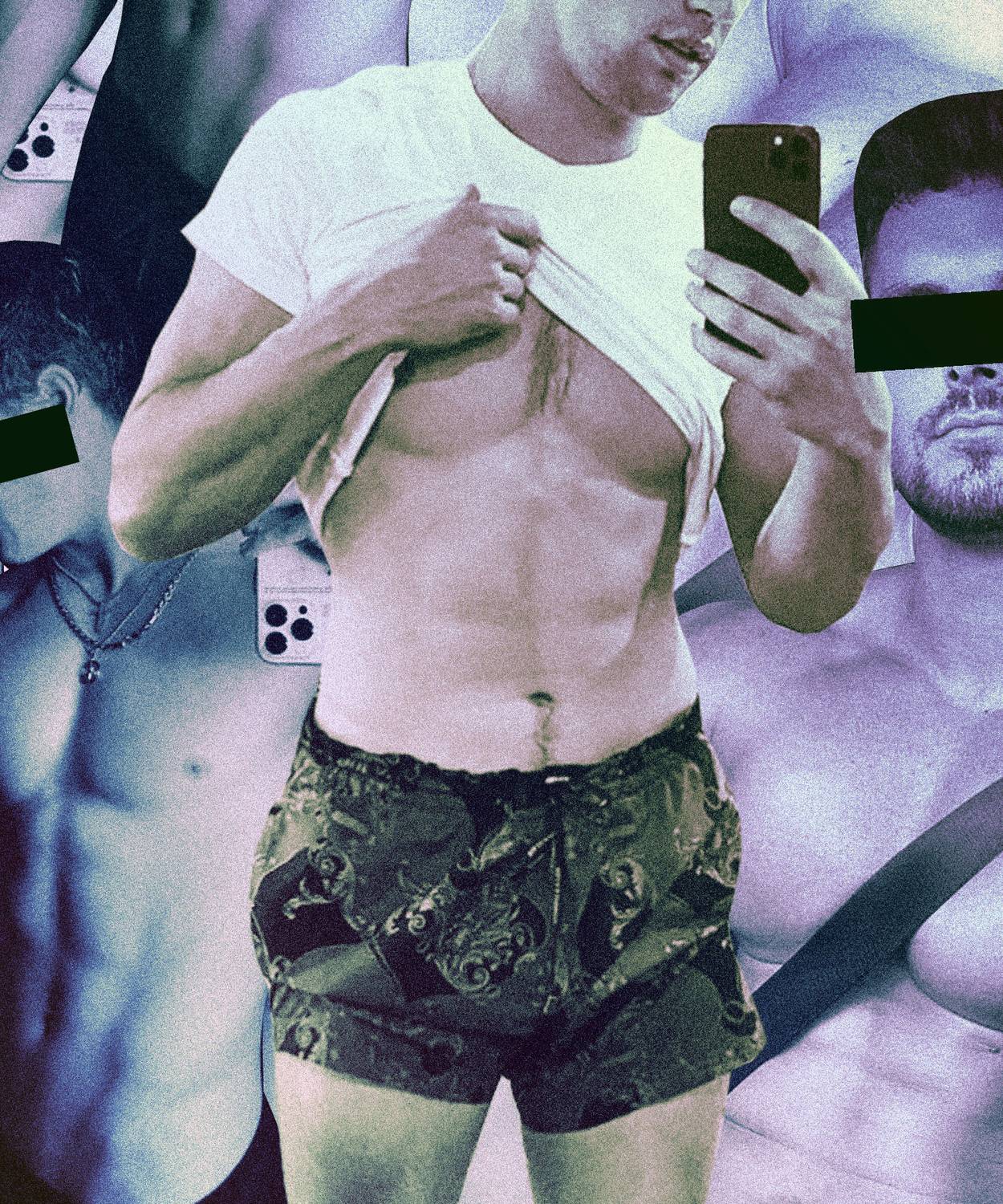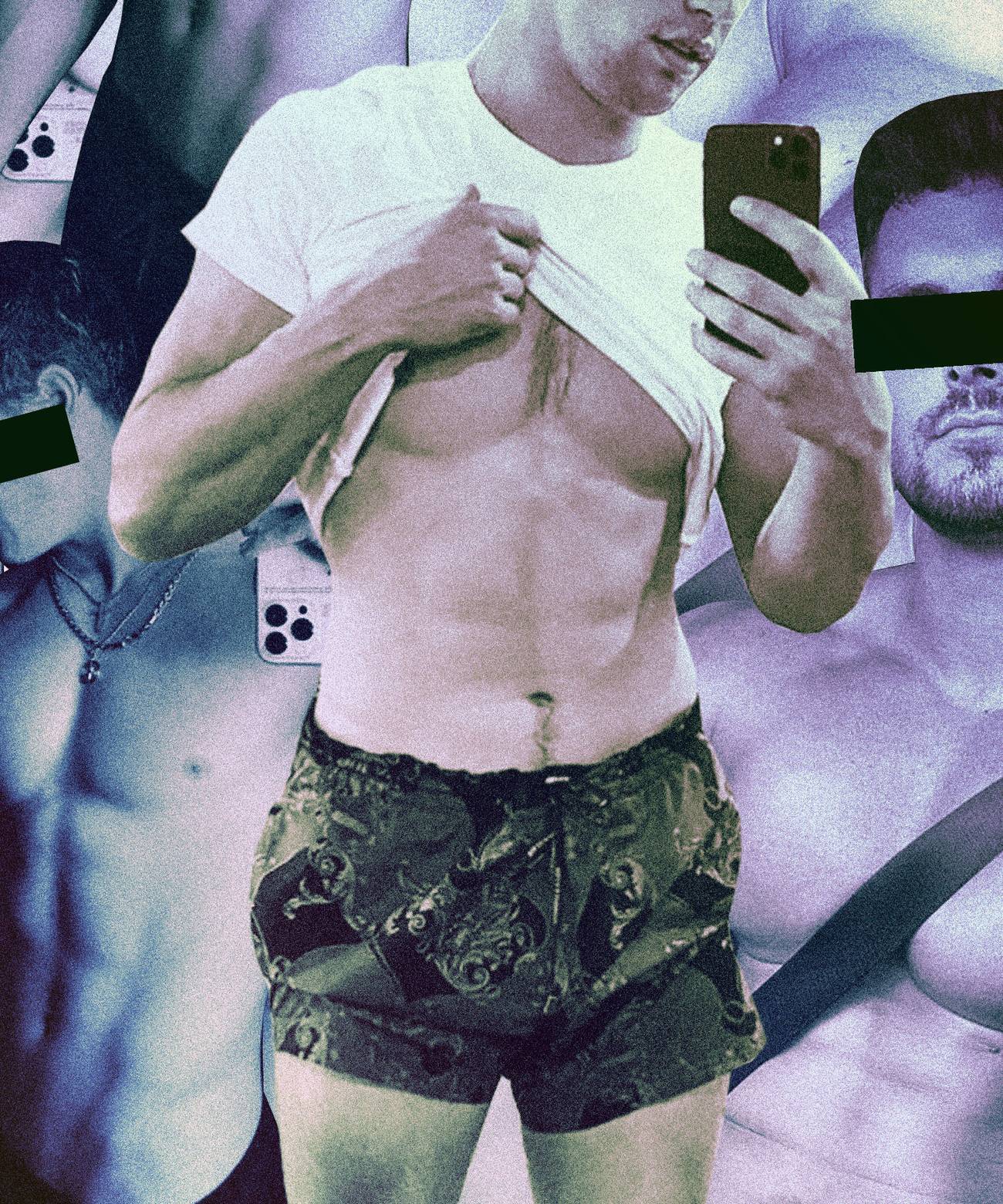The Angst of the Male Thirst Trapper
Gym selfies and posting ‘gainz’ on social media are symptoms of a world that is making men obsolete




“Yo you looking hella ockey bro. For real,” Guy One says to Guy Two as they leave the locker room. The lights turn off. I notice that it’s 9:59 p.m. The last worker on shift wants to leave. Guy Three pulls up his weathered black Nirvana T-shirt to dab the sweat from his forehead, then pulls it off. His two friends follow suit. “My traps hurt like hell, man,” one of them says.
All three pull out their phones and tap on the Instagram icon. They gather in front of a floor-length mirror as I awkwardly attempt to slip past them without making eye contact. They tense up their cores, flex one arm, and take a selfie with the other before switching arms and repeating the process. “Gotta show them these gainz, bruh,” says Guy Two. They throw on sweatshirts and grab their bags. “Yo bro,” one says on his way out the door, “did you check if she saw your story yet?”
A thirst trap is, according to Urban Dictionary, “a sexy photograph or flirty message posted on social media for the intent of causing others to publicly profess their attraction.” Thirst traps range from the simple to the highly curated, from the informal mirror selfie to the “candid” beach pic. The goal is for the poster to “trap” their prey in a fit of lust, leaving them with no choice but to write a comment or send a direct message indicating their sexual interest.
Thirst trappers must cautiously navigate the line between posting a photo that is too subtle, and thus unsexy, and one that is too sexual, and thus desperate and in poor taste. This is supposed to be a trap, after all.
At first glance, thirst traps perpetuate our culture’s oversaturation of sex. Yet the true intention behind posting a thirst trap, says one especially astute Urban Dictionary user, is not sexual pursuit—it’s to “feed the poster’s ego or need for attention.” Perhaps the thirst trapper, like many porn addicts, isn’t consciously aware of what it is they really want. But a thirst trap isn’t passive. Unlike the porn consumer, the thirst trapper actually stands a chance of getting human affirmation within a cosmos that seems hollowed out of lasting hope or objective meaning.
It is this aspect of individual assertion that explains why thirst-trapping has become increasingly popular among men, who are “flooding” social media platforms with their unabashedly sexual posts. Art critic John Berger famously quipped that “men act and women appear. Men look at women. Women watch themselves being looked at.” But now, with much of our lives mediated by screens and many traditional male social roles rendered obsolete, men also, increasingly, want to watch themselves being looked at. For growing numbers of young men, the thirst trap is a small cry, a demand for acknowledgement from a world that no longer needs them.
The social media selfie was once female. Gratuitous pictures of yourself, grouped under the hashtag #GPOY, were “a way to own one’s vulnerability, and also to buy into the most ancient currency on the internet—amateur, sexualized pictures of women,” Sonia Sariya wrote in a still-resonant 2012 BuzzFeed essay. “It’s the ultimate vulnerability,” she continues, “in a culture that constantly reinforces the fact that a woman’s only value is her appearance, to put it out in the public domain for comment.” Men, meanwhile, “have the option to opt out of the online beauty pageant.”
Except many chose not to opt out, even back then. Among the most prominent male selfie posters was the actor, director, eternal graduate student, and future #MeToo casualty James Franco, who penned a selfie apologia for The New York Times in 2013. “A well-stocked collection of selfies seems to get attention,” he wrote. “In this age of too much information at a click of a button, the power to attract viewers amid the sea of things to read and watch is power indeed.”
Selfies present themselves as a “real” snapshot of a person’s life, while in reality they are staged, calculated, and largely disintegrated from the natural flow of daily living. Franco himself is one of the early high-profile male thirst trappers, posting topless pictures of himself in quasi-intimate settings, like emerging from under the covers of his bed. The tension between selfies as an honest record of real life and selfies as a new form of self-advertisement in a digitized sexual marketplace were already there in the Franco essay. For Franco, shirtless preening says that “there is something important about me that clothes hide, and I don’t want to hide.” At the same time, “selfies are avatars: Mini-Me’s that we send out to give others a sense of who we are.”
Thirst traps, a subspecies of selfie, are inherently deceptive. Let’s go back to the gym for a moment: The “progress pics” I witnessed were clearly not being posted to record the attainment of certain fitness goals. Much more obviously misleading are the thirst traps with coy captions that distract from the sexual content of the picture. Take notorious thirst trapper Cameron Dallas, who posts captions like “need some more sun” in the midst of removing his top, or “omw to the museum” with his shirt half unbuttoned. Bachata singer Prince Royce posted himself climbing out of the sea onto a boat deck with the caption “feliz en el mar [happy in the sea]”. We are well aware that they are not posting these pictures out of the sheer desire to impart their excitement at getting a tan, viewing art, or going for a swim.
Today young men are constantly posting photos of themselves. Whether in the gym, on the beach, or waking up in bed, today’s dudes are always sensing a chance to arouse lust in whoever might be looking. At the same time as they are rushing to post erotic photos of themselves, they are mired in a culture in which their role and purpose is no longer obvious. Most men today are earning less than they did 40 years ago. Child-rearing is at historic lows. Those who are fathers “are not in a close relationship with their children” compared to earlier eras, according to sociologist Richard Reeves. Meanwhile, the culturally dominant ideal of manhood is that of the sensitive, neutralized male who never gives offense or makes anyone feel uncomfortable. One can argue this ideal has social benefits, but it’s hardly a call to the sort of heroism that men used to strive for.
“In the past,” says Joe Enabnit, the founder of a small privately owned gym in Minnesota, “it was easier for men to feel useful.” I found Joe while randomly searching #fitnessgoals photos on Instagram. Enabnit proved to be a thoughtful internal dissenter in the online world of fitness exhibitionism, an owner of a communal, “family-friendly” gym who is also fiercely anti-thirst-trapping. For Enabnit, gyms aren’t places to show off so much as civic trusts where like-minded people can work to better themselves.
“When jobs were more accessible to men, it was easier to play a more tangibly valuable role in one’s community, and thus to feel appreciated,” he explained. “But in today’s work-from-your-apartment world, our jobs feel meaningless and our local community doesn’t even need us.” Thirst-trapping, he insists, is a sad attempt to get attention and feel like one actually matters. “With Instagram filters, good lighting, and the right angle,” he continues, “[men] can get a lot of likes on their page … They get a sense of validation and a hit of dopamine when they get a click.”
Of course, one can also detect in male thirst traps the hollowed out vestiges of older, more primal instincts. Throughout time, says Lionel Tiger, the Charles Darwin professor of anthropology at Rutgers and author of The Decline of Males, “women have looked at men’s strength and attractiveness as a way to gauge their reproductive capacity and ability to earn.” Musculature and clear skin, for instance, can serve as signs of general genetic health. So men aren’t crazy to think that looking jacked online might be a ticket to easy attention from women. And yet, there’s something decidedly unheroic about thirst-trapping compared to older displays of masculine skill, ranging from mastery of comedy or literature to a facility for putting enemy cities to the torch. Using “an impersonal mechanism like the internet to achieve affirmation,” Tiger tells me, “already concedes a certain amount of defeat.”
We live in what philosopher Charles Taylor called a “disenchanted age”: Our identities and the material world around us are no longer charged with inherent spiritual meaning. Still, there are alternatives to traditional notions of God. These days, the need—the thirst, almost—for some higher meaning and affirmation doesn’t come from a deity as often as it comes from faceless internet users.
Within the unraveled cosmological framework of modern life, even a corporate gym can become a place where people search for something more. Unlike the old days of “physical culture clubs,” says Enabnit, where “close knit groups of friends [worked out] together,” at most corporate gyms we are likely to find “sad masses of people … alone, headphones in, avoiding eye contact, looking at themselves in the mirror.” The exerciser is an atomized entity, focusing on a different part of his disintegrated body each day, moving from machine to machine, just as he moves from relationship, to job, to mind numbing distraction without any sense of direction. He inadvertently emulates the motions of an assembly line, making himself one with the process of mass manufacturing with which the exercise machines were made. The exerciser repeatedly lifts weights up above his head, throws himself down to the ground, heaving and grunting—a parody of a rhythmic act of religious devotion, offering sacrifices to the gods—that is, to whomever will feed him affirmation. The treadmill is the archetypal sign of our times: a machine for running toward nothingness.
On a recent visit to the gym I noticed a young man carrying around a small camera tripod. Here was a thirst trap in progress: a man who was crying out, with every bench press, not only to some future sexual partner but to the virtual gods for some glint of validation. For some, a selfie is meant to incite lust and jealousy, even if it usually produces disgust at the cringiness, banality and vapid narcissism of the poster. But the selfie ultimately is a totem for our atomized age. In a culture divested of rituals and ceremonies, and lacking a framework through which we can interrogate an unquenchable thirst for being eternally “seen,” the thirst trap is a powerful expression of the need for meaning, for foundational truths, and for a beauty ever ancient, ever new.
Stephen G. Adubato studied moral theology at Seton Hall University and currently teaches religion and philosophy in New Jersey. He also is the host of the Cracks in Postmodernity blog and podcast. Follow him on Twitter @stephengadubato.